Slow arrival of aid frustrates Indonesia quake survivors
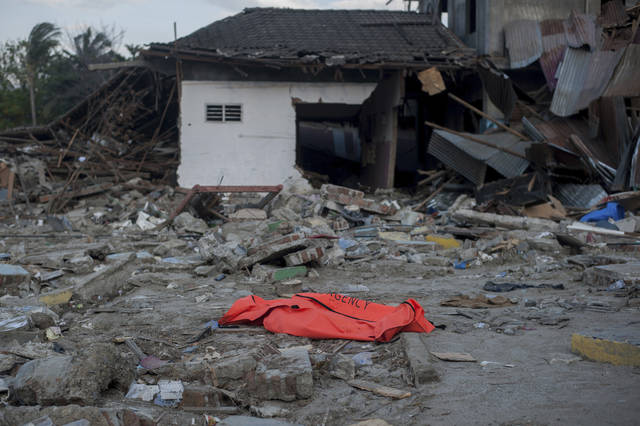
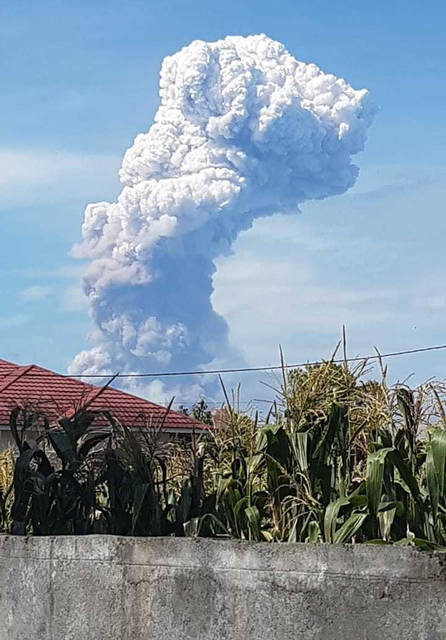
A giant plume of volcanic ash rises from Mount Soputan, Wednesday, Oct. 3, 2018, in the town of Tomohon, Northern Sulawesi, Indonesia. The volcano erupted Wednesday morning on the same central Indonesian island as an earlier earthquake and authorities warned planes about volcanic ash in the air. (AP Photo/Hetty Andih)
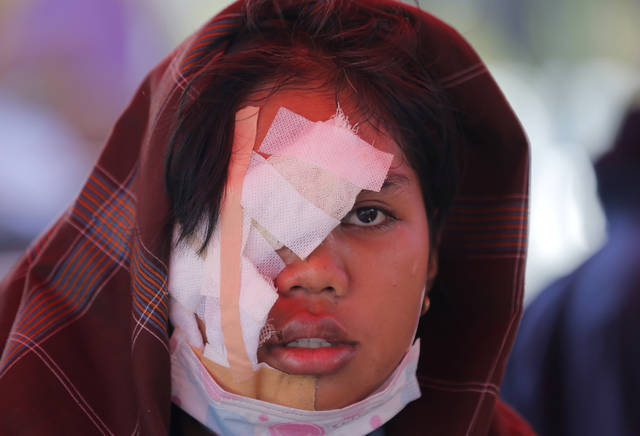
In this Wednesday, Oct. 3, 20-18, photo, an earthquake victim is bandaged at a makeshift hospital in Palu, Central Sulawesi Indonesia. (AP Photo/Tatan Syuflana)

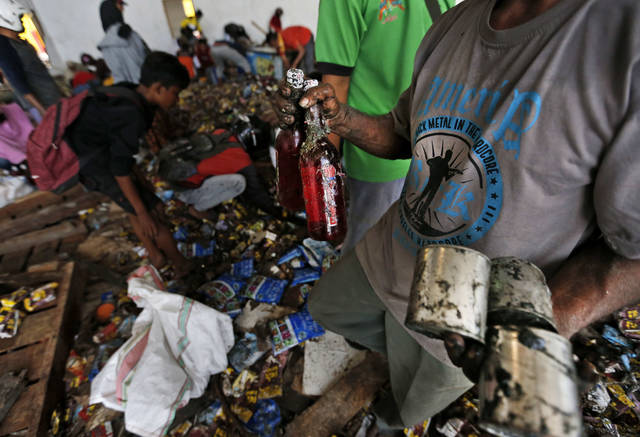
A man holds bottles of syrup and cans of condensed milk scavenged from an abandoned warehouse at an earthquake and tsunami-affected area in Palu, Central Sulawesi, Indonesia Indonesia, Wednesday, Oct. 3, 2018. Clambering over the reeking pile of sodden food or staking out a patch of territory, people who had come from devastated neighborhoods and elsewhere in the remote Indonesian city pulled out small cartons of milk, soft drinks, rice, candy and painkillers from the pile as they scavenge for anything edible in the warehouse that tsunami waves had pounded. (AP Photo/Dita Alangkara)
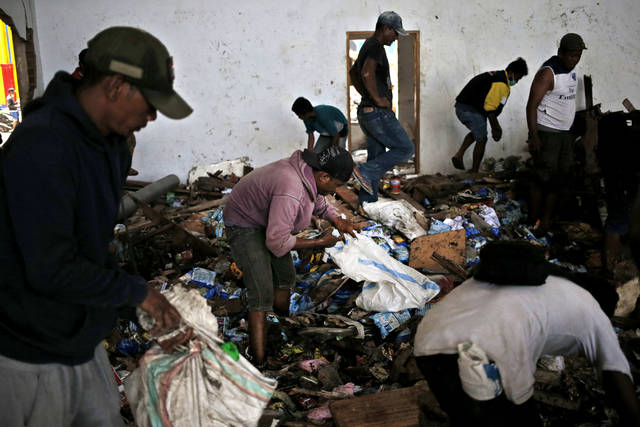
Men scavenge for food inside an abandoned warehouse in an earthquake and tsunami-affected area in Palu, Central Sulawesi, Indonesia Indonesia, Wednesday, Oct. 3, 2018. Clambering over the reeking pile of sodden food or staking out a patch of territory, people who had come from devastated neighborhoods and elsewhere in the remote Indonesian city pulled out small cartons of milk, soft drinks, rice, candy and painkillers from the pile as they scavenge for anything edible in the warehouse that tsunami waves had pounded. (AP Photo/Dita Alangkara)
PALU, Indonesia — Climbing over reeking piles of sodden food and debris, a crowd on Wednesday searched a warehouse wrecked in Indonesia’s earthquake and tsunami for anything they could salvage: cans of condensed milk, soft drinks, rice, candy and painkillers.
PALU, Indonesia — Climbing over reeking piles of sodden food and debris, a crowd on Wednesday searched a warehouse wrecked in Indonesia’s earthquake and tsunami for anything they could salvage: cans of condensed milk, soft drinks, rice, candy and painkillers.
A trickle of emergency aid is only now reaching parts of Sulawesi island, five days after the destructive quake that killed more than 1,400 people, and some increasingly desperate survivors are taking matters into their own hands.
“We came here because we heard there was food,” said Rehanna, a 23-year-old student, wearing a red motorcycle helmet. “We need clean water, rice.”
Elsewhere in the hard-hit city of Palu, residents clapped and cheered as they swarmed a truck that was finally delivering aid.
“I’m so happy,” said Heruwanto, clutching a box of instant noodles. The 63-year-old man, who like many Indonesians goes by only one name, added: “I really haven’t eaten for three days.”
Indonesian authorities have been struggling to get relief to survivors who have been left without food, water, fuel and medicine after Friday’s magnitude 7.5 quake and tsunami that smashed homes and businesses, downed communications and made roads impassable on Sulawesi.
The official death toll rose to 1,407 on Wednesday, with thousands injured and more than 70,000 displaced, said national disaster agency spokesman Sutopo Purwo Nugroho. He said the number of dead would increase, but that rescue crews had reached all affected areas.
The horror was still fresh in the minds of those like furniture maker Khairul Hassan, who was working at a shop near the beach in front of a row of warehouses when the ground shook violently. He ran to a hill and watched as the ocean heaved and hurled forward.
“I saw the waves come and sweep out everything — buildings, factories, warehouses and some people who were lost, racing from the waves, some of them women and children,” he said. “Also, warehouse workers who were trapped under goods, all swept by the sea. It’s so tragic. It’s so scary to remember.”
The Sulawesi coastline spreading out from Palu was a surreal landscape of debris, beached boats, overturned cars and the foundations of obliterated houses. Wrecked houses still standing were spray painted with appeals for aid. The wall of one dwelling was scrawled with the message: “Help us Mr. President.”
President Joko “Jokowi” Widodo visited the disaster zone Wednesday for a second time, saying there’s still work to be done, but that conditions were improving.
“We are going in phases. There are lots of things happening related to evacuation, as aid and fuel are also coming in,” he said, noting that 30 people remain buried under rubble at the Roa Roa Hotel in Palu.
The U.N. estimated that some 200,000 people need assistance, announcing a $15 million allocation to bolster relief efforts.
Australia said it will send 50 medical professionals as part of a $3.6 million aid package. The U.N. said the Indonesian Ministry of Social Affairs has asked UNICEF to send social workers to support vulnerable children who are alone or became separated from their families.
Some homeless residents weren’t waiting for help. Besides those searching for food, dozens of others combed a flattened complex of warehouses along Palu’s ravaged coast for anything they could sell or use to rebuild homes. They carted away corrugated metal, wood, piping and other items.
They included all ages, middle class and poor, university students and sullen young men.
“We have to do this because there’s no assistance from the government,” said Zaitun Rajamangili, 41, adding that his home was swept away but his family survived.
Rehanna, the student searching the warehouse for food, had come from Balaroa, a neighborhood of several hundred houses in Palu that was turned upside down by the quake and where many remain buried beneath the rubble.
“I’m very angry,” she said of the lack of aid. “I know the assistance is coming, but the distribution is very bad.”
Picking through the pile nearby was a 50-year-old woman named Rosminah, who had a plastic shopping bag bulging with muddy packets of food.
“There’s no support. Our house was destroyed,” she said. “We came here to search for food. There’s no assistance. We have to find it by ourselves.”
Following widespread looting and aid vehicles being stopped and surrounded by people on roads, Indonesian military chief Hadi Tjahyanto said one soldier and one police officer would be placed on every aid truck, and that soldiers would be sent to secure markets, the airport and fuel depots to maintain order.
He added that a Singaporean military transport plane will help evacuate victims from Palu. In addition, aircraft from South Korea, the United Kingdom and Japan were expected to ferry aid.
Separately, a volcano erupted on another part of seismically active Sulawesi island, about 940 kilometers (585 miles) northeast of the disaster zone.
It sent up a plume of ash more than 6,000 meters (20,680 feet) high. Planes were warned about the ash cloud billowing from Mount Soputan that can be hazardous for aircraft engines. No evacuations were ordered in the area.
Experts said it’s possible the quake accelerated the eruption, but there is no concrete evidence to prove that. Activity at the volcano had been increasing since August and began surging Monday, according to the head of Indonesia’s Volcanology and Geology Disaster Mitigation Agency.
The vast archipelago of 260 million people is frequently struck by earthquakes, volcanic eruptions and tsunamis because of its location on the “Ring of Fire,” an arc of volcanoes and fault lines in the Pacific Basin. A powerful quake on the island of Lombok killed 505 people in August.
———
Associated Press writers Niniek Karmini in Palu, Indonesia; Margie Mason and Eileen Ng in Jakarta, Indonesia; Rod McGuirk in Canberra, Australia; and Edith M. Lederer at the United Nations contributed.

